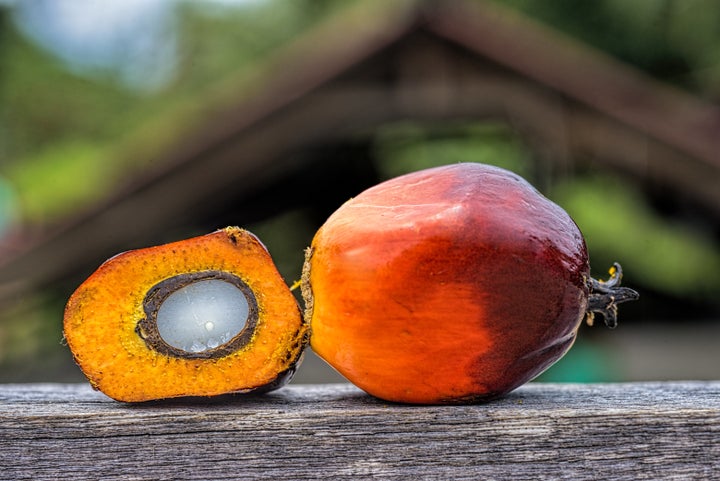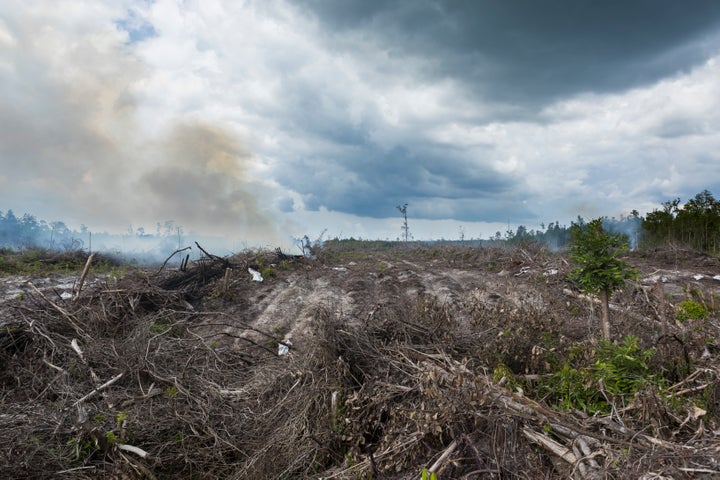Palm oil is almost impossible to avoid because it’s an ingredient in so many everyday items – from butter, cereals and ready meals to candles, lipsticks and shampoos.
Concerns over palm oil have been high on the agenda in recent years, but many of us don’t really understand what it is, how to spot it in ingredients or whether we should be avoiding it. To get you clued up, we’ve asked experts to explain.
[Read More: This is why I won’t boycott palm oil]
1. What Is Palm Oil And Where Does It Come From?
Palm oil comes from the fruit grown on oil palm trees, which are native to West Africa but thrive in tropical climates. The trees were introduced to Southeast Asia and South America in the 19th and 20th centuries.

Today, the largest palm oil producing countries are Indonesia and Malaysia, though it’s also produced in other countries including Thailand, Colombia and Nigeria. For farm workers and consumer goods companies around the world, oil palm trees are a hugely important crop.
2. How Do I Know If It’s In My Food?
Palm oil is versatile, cheap and semi-solid at room temperature, which makes it useful as an ingredient in processed food as it doesn’t instantly melt. Thanks to EU regulations, palm oil in the UK has to be clearly labelled on food products – so it should be easily identifiable if you look on the back of a packet.
Unfortunately, the same is not true of cosmetics where palm oil can be called a number of different things on a label. In fact, there are 200 different names used for palm oil, according to Greenpeace – these range from ‘amphoteric surfactant’ to ‘coco polyglucose’ which, let’s face it, aren’t exactly easy to remember. Handily, Palm Oil Watchdog has an A-Z guide that you can use here.
3. Is Palm Oil Bad For Us?
Palm oil is high in saturated fat so is best avoided in large doses (though so are other vegetable oils including olive, coconut and rapeseed).
It has some potential health benefits, as it contains tocotrienols, related to Vitamin E, which helps maintain healthy skin and eyes, and strengthens the body’s natural defence against illness and infection.

4. Is Palm Oil Bad For The Environment?
The problem is not with the plant itself, but the production of it. To get palm oil, you need to chop down trees – and this isn’t just a small-scale operation, it’s deforestation on a mass level. According to Greenpeace, it’s showing no sign of slowing down.
Rainforests, which are crucial habitats for animals like orangutang and tigers, have been burned and cleared to make way for these giant palm oil plantations. According to the WWF, Borneo alone has lost over half of its forests, and a third of these have disappeared, in just the last three decades. This, they say, is largely down to palm oil.
That being said, palm oil is actually an efficient crop that uses less land to produce more oil than many of the alternatives. A well-looked-after oil palm could be expected to yield fruit for three decades. For this reason, a spokesperson for Greenpeace said: “We do not advocate an alternative... existing plantations should be managed sustainably and there should be no more deforestation.”

However, Greenpeace wants to stop any palm oil being used in biofuels. “Cutting down rainforests to grow crops to make ‘green/eco’ fuel for our cars is completely counter-productive,” the spokesperson said.
5. So, Should I Be Avoiding Palm Oil?
If you want to consume more consciously, look for companies that claim to use 100% certified sustainable palm oil. “We want big brands to force their suppliers to buy palm oil from plantations and growers that can prove they are 100% sustainable,” a spokesperson for Greenpeace told HuffPost UK. “If they can’t prove it, they shouldn’t be buying the oil.”
Be aware that so-called sustainable palm oil isn’t without its own problems, though. Research from the BBC found supermarkets in the UK were unable to fully trace their palm oil – it found Tesco performed the best, but that it could only trace 67% of its palm oil to its source. Waitrose and Asda, according to the report, could only trace 50%.